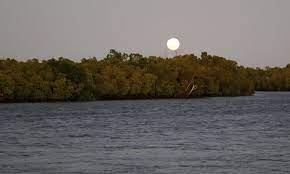Canberra, Sept 15: A wobble in the moon’s orbit around Earth affects mangrove cover across Australia and likely contributed to mass tree deaths in the Gulf of Carpentaria, new research suggests.
A study published in the journal Science Advances has found that an 18.61-year cycle known as the lunar nodal cycle shapes the condition of tidal wetlands.
The moon’s orbit around Earth does not occur in a flat plane. Since the 1720s, people have known that it moves up and down by a few degrees, said the study’s lead author, Prof Neil Saintilan of Macquarie University.
He likened the motion to when you’re spinning a coin as it loses momentum, it kind of wobbles. Changes in gravitational pull as a result of this lunar wobble are known to affect the Earth’s tides.
Previous research conducted by Nasa scientists has predicted that in the mid-2030s, the lunar wobble will amplify rising sea levels caused by climate change, resulting in high-tide floods along coastlines, the Guardian reported.
Depending on the phase of the lunar nodal cycle, there can be as much as 40cm of difference in the tide range in places such as the Gulf of Carpentaria, Saintilan said.
Mangroves grow between the average high-tide level and the highest high-tide levels, he said. At lower tidal ranges, mangroves are inundated less frequently.
When they’re stressed, because they lose water through their leaves, they just drop their leaves. The scientists used historical satellite imaging to quantify the extent of mangrove cover across Australia every year between 1987 and 2020.
The oscillation in canopy cover was immediately obvious when you graph the data, Saintilan said. (UNI)
Trending Now
E-Paper


